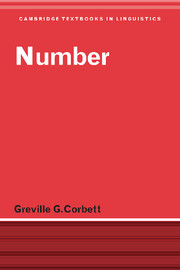Book contents
- Frontmatter
- Contents
- List of figures
- List of tables
- Preface
- List of abbreviations
- 1 Introduction
- 2 Meaning distinctions
- 3 Items involved in the nominal number system
- 4 Integrating number values and the Animacy Hierarchy
- 5 The expression of number
- 6 The syntax of number
- 7 Other uses of number
- 8 Verbal number
- 9 Conclusion and new challenges
- References
- Author index
- Language index
- Subject index
1 - Introduction
Published online by Cambridge University Press: 05 June 2012
- Frontmatter
- Contents
- List of figures
- List of tables
- Preface
- List of abbreviations
- 1 Introduction
- 2 Meaning distinctions
- 3 Items involved in the nominal number system
- 4 Integrating number values and the Animacy Hierarchy
- 5 The expression of number
- 6 The syntax of number
- 7 Other uses of number
- 8 Verbal number
- 9 Conclusion and new challenges
- References
- Author index
- Language index
- Subject index
Summary
Number is the most underestimated of the grammatical categories. It is deceptively simple, and is much more interesting and varied than most linguists realize. This was recognized by Jespersen: ‘Number might appear to be one of the simplest natural categories, as simple as “two and two are four.” Yet on closer inspection it presents a great many difficulties, both logical and linguistic’ (Jespersen 1924: 188). Lyons too pointed out its interest: ‘The analysis of the category of number in particular languages may be a very complex matter’ (Lyons 1968: 283). This book will illustrate the interest of number, and some first pointers are given in §1.1.We shall also see the challenges which Jespersen and Lyons allude to, one of the trickiest being the need to ensure that as we compare across languages we are really comparing like with like (§1.2). Hence the book is structured so as to work upwards from properties that are safe building blocks for comparison (§1.3). Finally in this introduction a few notes on presentation are needed (§1.4).
The special interest of number
Despite the significance of number, there are still surveys of linguistics where it receives a footnote's worth of attention. This is largely because there are some reasonable but incorrect assumptions about number, which are generally based on the consideration of a rather limited range of languages.
- Type
- Chapter
- Information
- Number , pp. 1 - 8Publisher: Cambridge University PressPrint publication year: 2000

